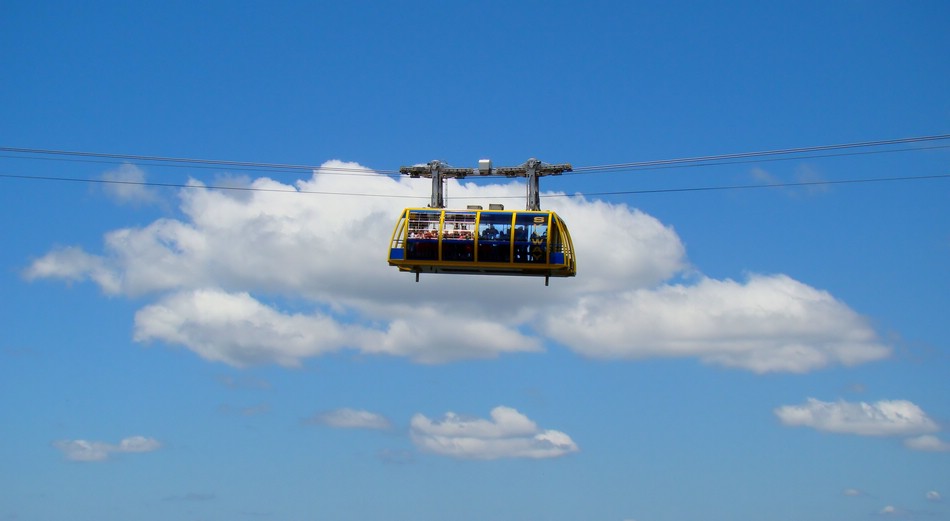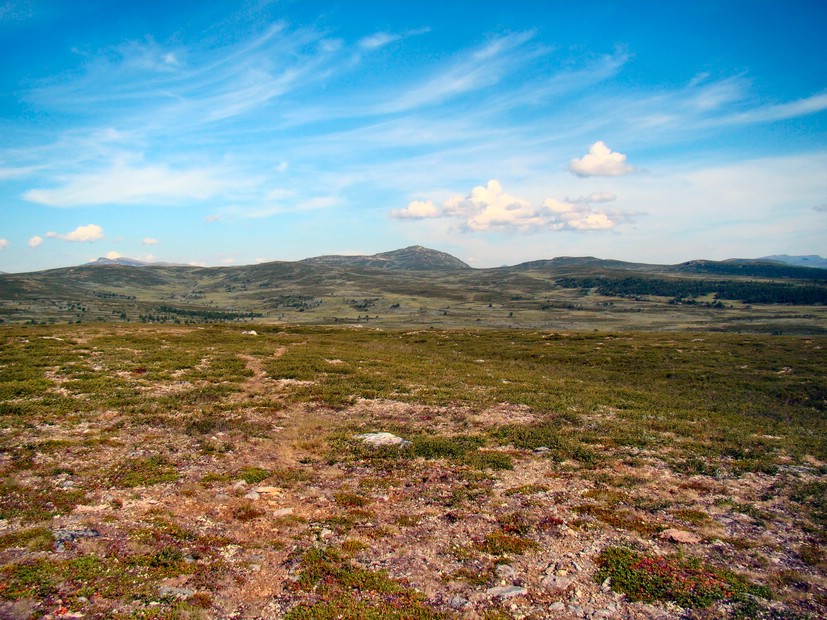 Oh, and before we continue: When I say "a long walk", I'm talking about multi-day walks with few or none man-made facilities around to help you. Well, apart from what you can carry on your own back and possibly a trail, that is.
Oh, and before we continue: When I say "a long walk", I'm talking about multi-day walks with few or none man-made facilities around to help you. Well, apart from what you can carry on your own back and possibly a trail, that is. Why on Earth?!
Most people are happy to walk a bit to see a particular place or to enjoy a great view. As long as the walk isn't too long, at least. All the recent fuzz about climate change and the need to be eco-friendly has made people want to return to Nature. They just don't necessarily want to do it on foot.
In principle there's no big difference between a short and a long walk in the wild. You get on the trail, you do your best to stay on it until you reach the end of it, and then you're done. In people's minds, however, there's something intimidating about long walks. They are perceived to carry a much larger risk than short walks, although you rarely get an explanation for why people feel that way.
Maybe the phenomenon can be explained like this: Say you take a nice, wide board and lay it down on the floor so that anyone easily can move back and forth on it. That's a short walk. Then you place the same board high up in the air between two towers. Now most people I know will be reluctant to go out on it. This is a long walk. The board is the same in both cases, but as the consequences of falling off the board become more dire, people's willingness to walk across the board decreases dramatically. This mental mechanism kicks in no matter how unlikely it is that you actually will fall off the board.
It's a bit like if you were invited to eat at a restaurant. "Yay!", you think at first. Then it turns out that the restaurant you're invited to is an Helvanian one. You've never been subject to Helvanian cuisine before, and the menu is printed in letters and a language you just cant't read. You know that you will be served food, but since you don't know exactly what you will be eating or how it has been prepared, you end up feeling a bit wary and insecure. Suddenly going for a Big Mac instead doesn't sound so bad, even though deep inside you know that if you just dare to go ahead with the Helvanian place, you'll probably end up with a nicer meal than at the American embassy beneath the golden arches.
Oh well. Enough metaphors. Let's establish a few good reasons for taking long walks.
For the view?
If you're into great scenery, long walks tend to offer a lot of that. In many cases you can enjoy splendid views from or very close to a parking lot, but to really appreciate a place, you should see it from more angles than the one you get from next to the souvenir stalls.
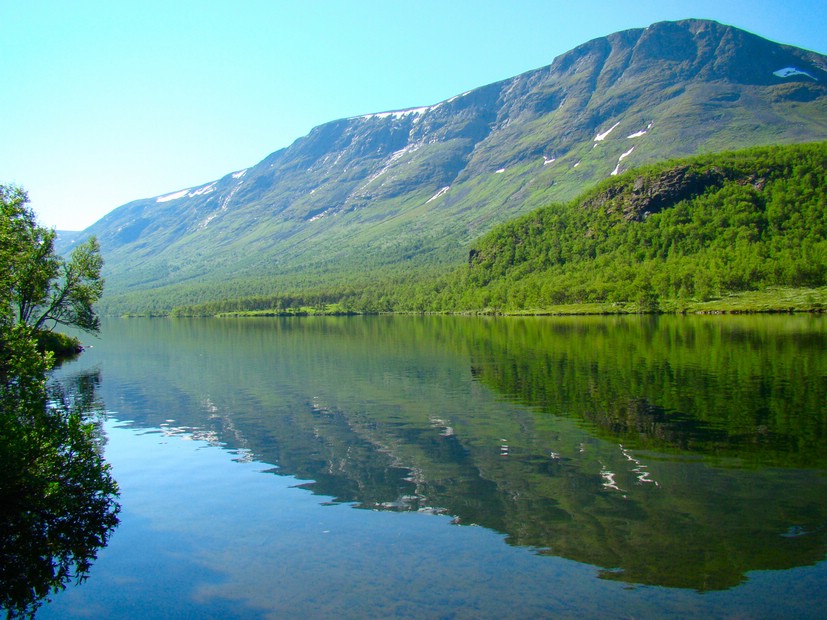 On the other hand, the quality of a scenic view often depends heavily on the weather. And what conditions you will experience when you arrive somewhere can rarely be guaranteed when you have to start walking days earlier.
On the other hand, the quality of a scenic view often depends heavily on the weather. And what conditions you will experience when you arrive somewhere can rarely be guaranteed when you have to start walking days earlier. I'd say that the view you may or may not enjoy on your trip should probably not be your main reason for taking a long walk.
For the vanity?
I once did an 11 day walk (the Jotunheimen Trail of about 350 kilometres), and I made a photojournal from the trip that I uploaded to my Web site. A few days later I logged a crazy number of Japanese visitors. It turned out that a Japanese weightloss Web site used my before-and-after self-portraits from the trip as "proof" that going for a walk is a good thing to do if you're a bit on the chubby side.
 Now, I wasn't particularly flattered by that, but I was amused. #8D)
Now, I wasn't particularly flattered by that, but I was amused. #8D)Anyway, going for a long walk will make you a slimmer person. When you walk all day, you can eat as much chocolate as you could possibly want without suffering from it weight-wise. More importantly, walking in the wild is what your genes want you to do. Unless you overdo it, there's a good chance that after a long walk you'll end up looking a lot healthier. (Never mind that when you return home you may prefer to carry a pillow with you to put between your boney ass and any hard seats.)
As long as you can avoid being eaten by animals and falling off cliffs, walking will benefit your health and your appearance. This is a good reason for going on long walks.
For the company?
On many long walks you will spend your evenings at designated camp sites, where you may or may not encounter other hikers. On other walks days may pass between each time you actually see another human being.
If you're on popular trails with designated camp sites, like the Overland Track in Tasmania, the Jotunheimen Trail in Norway and the Appalachian Trail in the USA, you'll probably see the same people again and again, throughout the day and at the camp sites in the evenings.
I'm not saying that these people are particularly interesting, but they are likely to have a lot in common with you. This will at least make them interesting to you, and vice versa. You'll be amazed by how quickly strangers can turn into good friends when you share the challenge of a long walk with them. They will help and motivate you, and you them. True, some of them will annoy you, and they will all be smelly. Still, all in all you'll appreciate having other people around, and you will learn something from having met them.
On the other hand, there are many long walks where you must be prepared to spend day after day without anyone at all to talk to or be helped by. This can be difficult to handle.
Make sure you're prepared for the situation that your walk is likely to bring, whether this means sharing a dorm with the German national snoring team, or having to spend a week or more without a single intellectually stimulating conversation. Life on the trail can be pretty hard either way.
For the lack of alternatives?
Sometimes there's just one way to get somewhere, and that's by walking, possibly for days and days before it gets really interesting. In particular this goes for mountain regions where roads just can't be built, and where sitting on a horse or a donkey would simply be too scary.
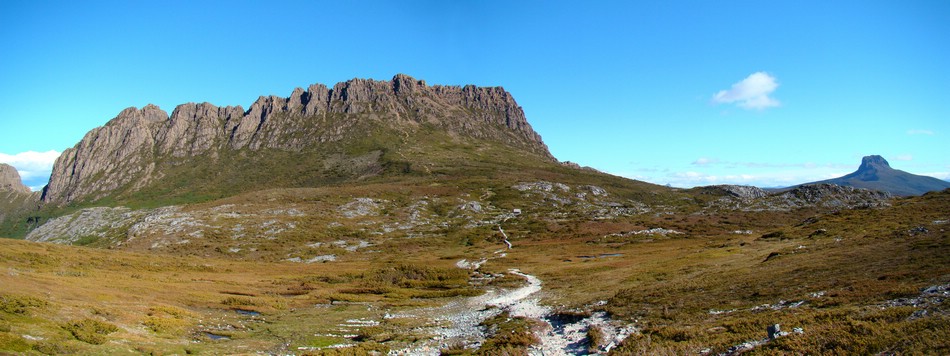 Clearly, unless you're ready to walk a long way, you will deny yourself some of the greatest scenery on Earth. I think you're better off treating yourself to some of those places.
Clearly, unless you're ready to walk a long way, you will deny yourself some of the greatest scenery on Earth. I think you're better off treating yourself to some of those places. For the enlightenment?
Few people know what they are capable of. They just assume that any strenuous activity that they have never tried or wanted to do is something they simply cannot do.
Every now and then the news media bring reports of people who have to flee their homes. In Palestine, Afghanistan, Sudan and elsewhere, thousands of often undernourished refugees walk through deserts, jungles and generally the most hostile surroundings you can imagine, to reach relative safety.
Let's hope that you will never fully understand what these individuals experience. But one of the things their suffering can teach us is that the human body is one impressive machine. The same way you would take your imaginary sports car for a spin on a race course to see what it's good for, you should consider exploring the abilities of your own body. Chances are that you'll be pleasantly impressed. You'll probably discover that you can participate in a much wider range of activities than you previously thought possible.
Oh, and there's of course also some satisfaction to be had from having completed a walk that is so long that the route you followed can be pointed out from Outer Space. #8D)
 As you may gather, I consider this to be a major reason for pushing yourself to do a long walk or two.
As you may gather, I consider this to be a major reason for pushing yourself to do a long walk or two.Preparing
Right, so you've decided you'll do a long walk. Then there's something you should know: In Nature there are no punishments or rewards, only consequences. So you have better prepare well for your walk, in order for you to harvest only desirable consequences.
I suggest that you seek inspiration in the first step that is taken by members of Alcoholics Anonymous when they try to resolve their situation: Admit to yourself that you have a problem! Do not belittle the challenge of getting through your walk alive. You have to take it very, very seriously.
Read all you can find about your walk, on-line and in magazines and books. Anything written by anyone who has done the walk is useful. The more recently they did it, the more valuable their information is likely to be to you. What will the weather be like and how does it affect walking the trail? Which parts of the walk are more difficult and for what reason? Is chocolate available somewhere along the way?
The same way you must know how to interpret the behaviour of your own mind and your own body, you need to know your opponent; the walk itself and the land it passes through.
Equipment
I'm not going to tell you what to bring. All I can say is that you must bring whatever you need in order to feel comfortable and safe on your hike. This clearly varies depending on where and when you're hiking and for how long you'll stay on the trail.
In my opinion, people tend to over-invest in new equipment when they're about to embark on long walks. Of course, if buying some new stuff is what it takes to make you feel safe enough to get going, then that's probably what you should do. But keep in mind that unless you're doing a really extreme hike, people managed to do "your walk" even before the invention of things like Gore-Tex, GPS and the steam engine...
Packing
When you've decided what you need to bring, put it all into your backpack. If it fits, great! If not, throw away stuff until it does. Now take the backpack for a test walk in terrain similar to what you will encounter on your trip. Don't forget to also carry as much water as you will have to on your real hike. Walk for two hours. Remove your backpack.
If this results in the notion that you should hold on to something in order not to float up into the air and disappear, your backpack is too heavy! (And it probably is.) In that case you will have to get rid of some things. Do not bring books (you'll be too tired to read them) and do not bring more than two changes of clothes. (It will all be filthy and smelly after a couple of days on the trail anyway.)
Do not begin your hike until you are confident that you will be able to carry your stuff all the way to your destination. Just don't. It's not like you have to remove your appendix or have your hair cut, but you have to make an effort to get rid of all weight that takes more than it gives.
Maps
Choose maps that cover your trip and not too much else. Maps have size and weight, too. Carry only exactly the maps you need, and make sure you know how to use them. In many areas a map is no good unless you also bring a compass. GPS devices are often useless on long walks, since there will be little or no electricity available along the way.
For most famous treks you can buy small booklets that contain just the maps and trail descriptions that you need. If not, you can make one yourself by cutting and pasting map fragments from maps you scan/photograph or find on the Internet. Print your new map with a high-resolution laser printer onto a semilarge (A3) piece of paper. Click on the image below to see an example of a 320km trail map made this way.
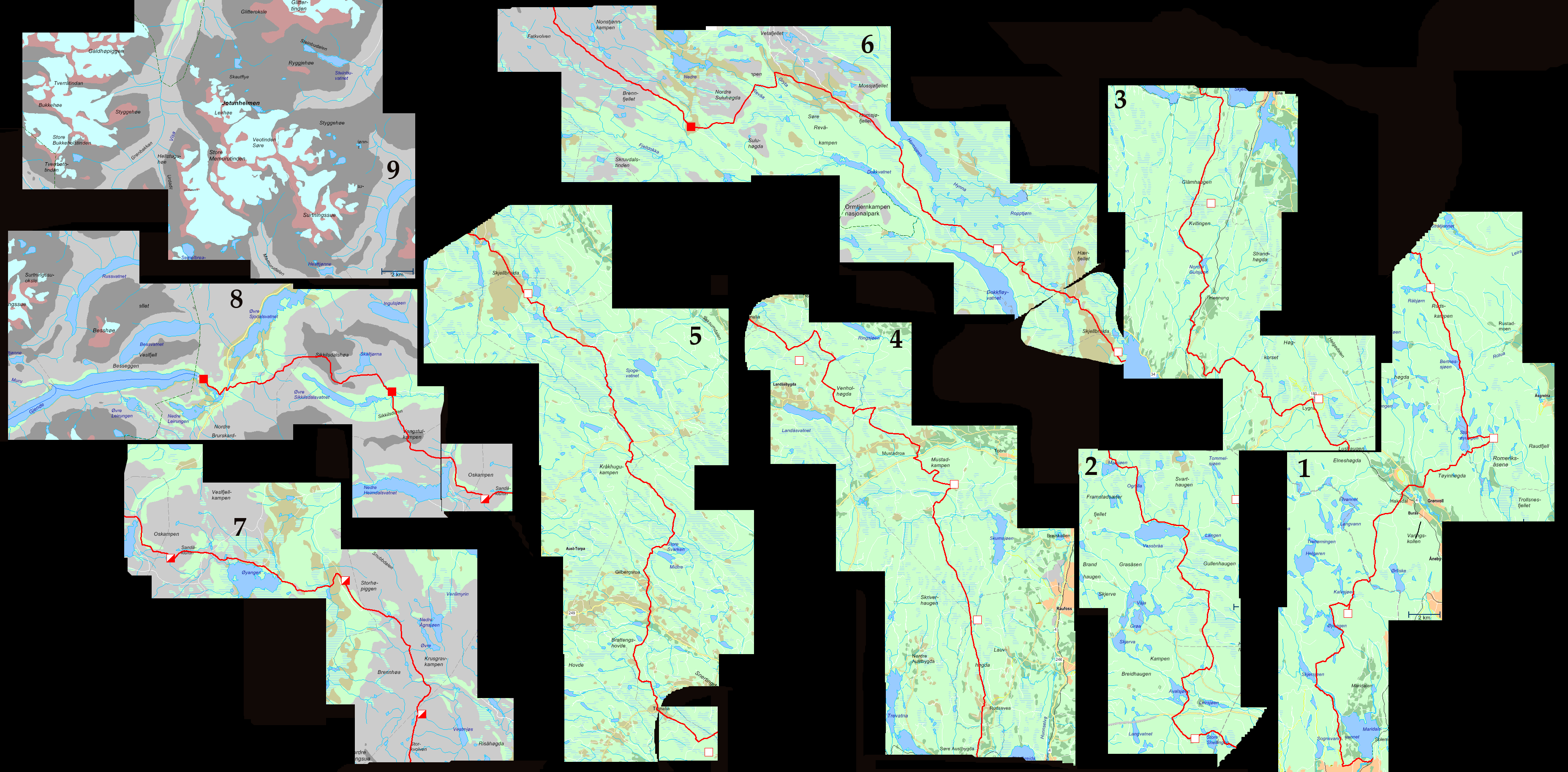 A detailed map is probably not something you really need in order to complete your walk. Long walks usually follow good, clearly visible paths. But every time you take a break and sit down, it is a great inspiration to have a glance at a map and see that you're actually getting closer to your destination.
A detailed map is probably not something you really need in order to complete your walk. Long walks usually follow good, clearly visible paths. But every time you take a break and sit down, it is a great inspiration to have a glance at a map and see that you're actually getting closer to your destination. Before you leave home, carefully study the maps you have, so that you understand the area you're hiking through. Look for sources of water and places to camp. Maybe there are sidetrips you should look into. It's impossible to know beforehand exactly how far you can walk per day. You should have several options for where to stop every day, with no more than 2-3 hours of walking between them. This way you can be flexible and get the most out of every day on the trail.
There's also a chance you will have to break off your journey, due to mishaps or simply because you're worn out. You should know where all the "emergency exits" are. Find out where you can leave the trail to return home or to seek help, and make sure that you know where you can fill up on supplies of food and equipment. If it's an option at all, try to figure out where there may be cell phone coverage, in case of emergencies or to acquire the latest weather forecast.
Other tips
I think we've touched upon the most important issues already, but I've suffered from a few things that I hope to help you avoid. #8D)
- Make sure you know how to use your equipment before you leave home, whether that be your tent, your stove or anything else. The entertainment value of figuring out exactly which hole the tent poles should be inserted into is not so high when you're simultaneously the target of an intense mosquito attack during the darker part of dusk.
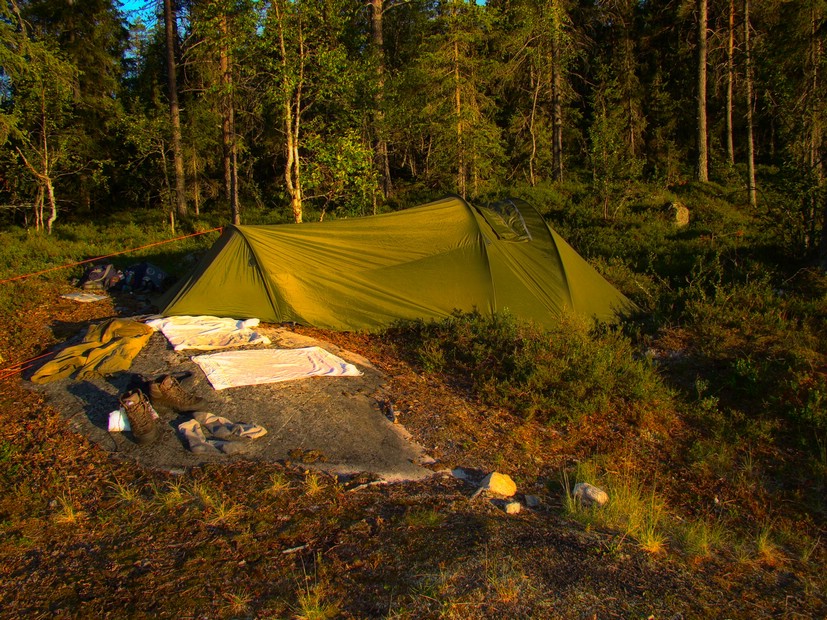 - When you finally have decided on some food you can carry in sufficient amounts in your backpack, you'll probably discover that this trip will not be remembered for its many great meals. You should try living on this diet for a few days at home, so that you can learn how it affects you, both mentally and physically. Especially if you're walking with someone else. Some people turn incredibly grumpy when their daily rations of certain food ingredients disappear.
- When you finally have decided on some food you can carry in sufficient amounts in your backpack, you'll probably discover that this trip will not be remembered for its many great meals. You should try living on this diet for a few days at home, so that you can learn how it affects you, both mentally and physically. Especially if you're walking with someone else. Some people turn incredibly grumpy when their daily rations of certain food ingredients disappear. The food must be your friend on your long walk. You don't have to be delighted by it, but it must not turn you into a walking wreck either.
- Cut your toenails! If you do, you may have some of them left after your hike! While your shoes may be friendly towards the other parts of your feet, having your toenails continuously bump into the front of your shoes for hundreds of kilometres will turn the toenails black and eventually they will fall off. That's not sexy at all.
In Conclusion
You can do this. A little bit of planning is all it takes.
I recommend that you start out with getting used to carrying a fairly heavy backpack and that you spend a few days camping out in the woods near where you live. When you feel ready for something more, consider whether some of the trips listed below may be something for you. Good luck!
Some famous, long walks, in alphabetical order:
* Abel Tasman Coast Track
Location: South Island, New Zealand
Distance: 52km, 3-5 days
Booking: Required, *well* in advance!
More info
* Via Alpina / Alpine Pass Route
Location: Switzerland
Distance: 350km, 20 days
Booking: Not required
More info
* Annapurna Circuit
Location: Himalaya, Central/Eastern Nepal
Distance: 250km + sidetrips, 15-25 days
Booking: No, but trekking permit is required
More info
* Appalachian Trail
Location: Georgia to Maine, USA
Distance: Approximately 3500km
Booking: Not required
More info
* Bibbulmun Track
Location: Western Australia, Australia
Distance: 961km, 6-8 weeks
Booking: Not required at all.
More info
* Camino de Santiago / Way of Saint James
Location: France and Spain
Distance: Many starting points, 100 - 900km,
Booking: Not required.
More info
* Inca Trail
Location: Central Peru
Distance: 45km, 3-4 days (high altitude, not strenuous)
Booking: Very much required.
More info
* Jotunheimstien / Rondanestien
Location: Southern Norway, beginning in Oslo
Distance: 320km-420km, 12-25 days
Booking: Not required.
More info (and more)
* Kungsleden
Location: Northern Sweden
Distance: 440km, 3-4 weeks
Booking: Not required.
More info
* Land's End to John o' Groats
Location: The length of the United Kingdom
Distance: Approximately 1500-1900km
Booking: Not required
More info
* Mount Everest Base Camp Trek
Location: Himalaya, Eastern Nepal
Distance: Depends on starting point, 15 days is normal
Booking: No, but trekking permit is required.
More info
* Overland Track
Location: North-western Tasmania, Australia
Distance: 65-100km, depending on sidetrips, 5-7 days
Booking: Required between November and March.
More info
* Torres del Paine Circuit
Location: Patagonia, Southern Chile
Distance: 100km + sidetrips, 8-10 days
Booking: Only for cabins
More info
Do you need even more options? Look here.
Happy trails!

